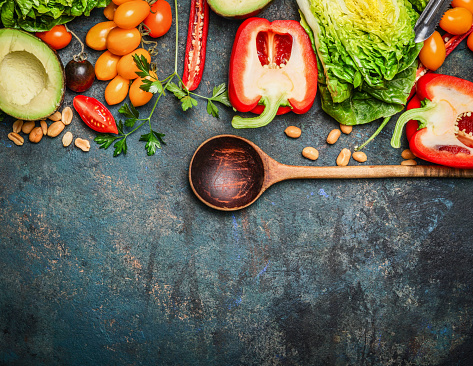
Eight ways to cook vegetables
Learn how to prepare vegetables to retain their properties
You should eat five servings of fruits and vegetables every day, and two or three of these should be greens or other vegetables.
That’s why it’s important to cook them in different ways and to prepare a variety of dishes, while taking care not to lose those nutrients that make them so healthy for us.
-
Raw
Some vegetables, such as the potato, can be eaten raw. However, most vegetables can be eaten raw and, as well as being delicious, all their nutrients remain intact.
You must wash them thoroughly to eliminate dirt and pesticides but you cut them up any way you like to prepare all kinds of salads and cold garnishes.
-
Boiling
Boil the water, add one teaspoon of salt for each litre, and then add your vegetables. This will stop the nutrients from leaking into the water. Keep them in large pieces, because chopping encourages oxidation.
Keep the water on the boil and your veg will cook quickly and evenly. Even so, some of the flavour of the vegetables and some vitamins and minerals are lost in the water, so make sure you use only the amount needed and cook for the shortest possible time. To minimise this loss, use a pressure cooker to cut cooking times.
-
Steaming
Steaming is not the quickest way to cook vegetables, but their flavour and aroma are better. On the downside, because the food is not in contact with the water, it may be less juicy. If you don’t have a special steamer for this type of cooking, use a saucepan with a little boiling water and place a metal sieve or colander inside, ensuring that the food doesn’t touch the water.
-
Sautéing
Frying vegetables in a pan with just a drop of oil conserves minerals such as magnesium, calcium and iron that are partly lost in water. Vegetables cook more quickly in the outside than on the inside and they stay juicy. If you use a wok instead of a frying pan, the heat is distributed more evenly and the food cooks better.
-
Roasting
Some vegetables, such as tomatoes, peppers and onions taste excellent when roasted. If you cook them ‘en papillote’, wrapped in aluminium foil, they will keep their water content and stay juicy. Nutrients are not lost and they are more flavoursome. If you use a grill, you’ll need a higher cooking temperature is higher and the outside of the vegetables may burn, producing toxic substances and taking the flavour of the embers, which masks the taste of the food itself.
-
Microwaving
This shortens cooking times substantially. By changing the polarity in the magnetic field inside of the oven, water molecules of water in the food change direction and vibrate. This cooks the food quickly, although it loses water and sometimes can be dry. However, the nutrients remain intact.
-
Slow frying
We often chop up vegetables finely and then slow cook them in olive oil. They may lose some vitamins due to oxidation, but their flavour and aroma are enhanced.
-
In purées
Firstly, this reduces their fibre content, because the fibre is cut and crushed. Cook the vegetables in very little salted water, with salt and the lid on the pan, for just long enough for them to be puréed. This cooking method is a very healthy option and suitable for children and the elderly who cannot manage them any other way.
The best thing you can do is eat vegetables cooked using all methods. Try them all and decide which you prefer. Don't forget that they are an essential part of your diet, however you prepare them.
This post is also available in: Italian
